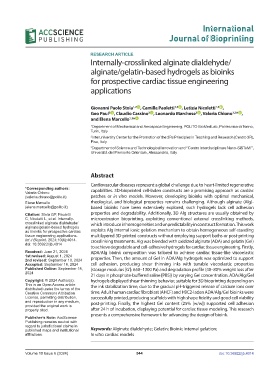Page 552 - IJB-10-6
P. 552
International
Journal of Bioprinting
RESEARCH ARTICLE
Internally-crosslinked alginate dialdehyde/
alginate/gelatin-based hydrogels as bioinks
for prospective cardiac tissue engineering
applications
Giovanni Paolo Stola 1,2 id , Camilla Paoletti 1,2 id , Letizia Nicoletti 1,2 id ,
Geo Paul 3 id , Claudio Cassino 3 id , Leonardo Marchese 3 id , Valeria Chiono * ,
1,2 id
and Elena Marcello *
1,2 id
1 Department of Mechanical and Aerospace Engineering, POLITO BioMedLab, Politecnico di Torino,
Turin, Italy
2 Interuniversity Center for the Promotion of the 3Rs Principles in Teaching and Research (Centro 3R),
Pisa, Italy
3
Department of Science and Technological Innovation and “Centro Interdisciplinare Nano-SiSTeMI”,
Università del Piemonte Orientale, Alessandria, Italy
Abstract
Cardiovascular diseases represent a global challenge due to heart-limited regenerative
*Corresponding authors: capabilities. 3D-bioprinted cell-laden constructs are a promising approach as cardiac
Valeria Chiono
(valeria.chiono@polito.it) patches or in vitro models. However, developing bioinks with optimal mechanical,
Elena Marcello rheological, and biological properties remains challenging. Although alginate (Alg)-
(elena.marcello@polito.it) based bioinks have been extensively explored, such hydrogels lack cell adhesion
Citation: Stola GP, Paoletti properties and degradability. Additionally, 3D Alg structures are usually obtained by
C, Nicoletti L, et al. Internally- microextrusion bioprinting, exploiting conventional external crosslinking methods,
crosslinked alginate dialdehyde/ which introduce inhomogeneities and unpredictability in construct formation. This work
alginate/gelatin-based hydrogels
as bioinks for prospective cardiac exploits Alg internal ionic gelation mechanism to obtain homogeneous self-standing
tissue engineering applications. multilayered 3D-printed constructs without employing support baths or post-printing
Int J Bioprint. 2024;10(6):4014. crosslinking treatments. Alg was blended with oxidized alginate (ADA) and gelatin (Gel)
doi: 10.36922/ijb.4014
to achieve degradable and cell-adhesive hydrogels for cardiac tissue engineering. Firstly,
Received: June 21, 2024 ADA/Alg bioink composition was tailored to achieve cardiac tissue-like viscoelastic
1st revised: August 1, 2024 properties. Then, the amount of Gel in ADA/Alg hydrogels was optimized to support
2nd revised: September 10, 2024
Accepted: September 18, 2024 cell adhesion, producing shear thinning inks with tunable viscoelastic properties
Published Online: September 18, (storage modulus [G’]: 650–1300 Pa) and degradation profile (40–80% weight loss after
2024
21 days in phosphate-buffered saline [PBS]) by varying Gel concentration. ADA/Alg/Gel
Copyright: © 2024 Author(s). hydrogels displayed shear thinning behavior, suitable for 3D bioprinting depending on
This is an Open Access article the ink stabilization time, due to the gradual pH-triggered release of calcium ions over
distributed under the terms of the
Creative Commons Attribution time. Adult human cardiac fibroblast (AHCF) and H9C2-laden ADA/Alg/Gel bioinks were
License, permitting distribution, successfully printed, producing scaffolds with high shape fidelity and good cell viability
and reproduction in any medium, post-printing. Finally, the highest Gel content (25% [w/w]) supported cell adhesion
provided the original work is
properly cited. after 24 h of incubation, displaying potential for cardiac tissue modeling. This research
presents a comprehensive framework for advancing the design of bioink.
Publisher’s Note: AccScience
Publishing remains neutral with
regard to jurisdictional claims in
published maps and institutional Keywords: Alginate dialdehyde; Gelatin; Bioink; Internal gelation;
affiliations. In vitro cardiac models
Volume 10 Issue 6 (2024) 544 doi: 10.36922/ijb.4014

